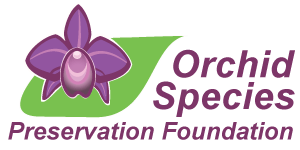With over 30,000 species of orchids identified world wide and more being discovered each year, a complex grouping and naming protocol has been develop by botanists over the years. The recent use of DNA technology has greatly helped in identification of family groupings and their relationships.
For the novice, a few things are important to know. The genus name (first word) is the ‘group or family’ name, written in italics with its first letter capitalized. The species name (second word) is the name of the individual’s species, also italicized, but the first letter is always in lower case. If the second name starts with a capital letter it is then a hybrid orchid (a cross between two individual species or hybrids – usually man made).
Cattleya rothschildianum var. blue ‘Blue Boy’ AM/AOS
family species description growers gives awards
In the past, the second name was a ‘Latinized’ version of the name of the individual who discovered the orchid. (e.g. Rothschild yields rothschildianum)
Following the first two names, a description or version name follows, such as ‘alba’ (an albino form) and/or a given name to identify a plant with unique characteristics among its siblings (growers will sometimes recognize a family member eg. ‘Mary’).
Finally, there may follow a series of abbreviations in capital letters. These indicate the awards that the plant has received by orchid show judges, and when purchasing an orchid, the more awards the better. (eg. AM /AOS)
On labels you will find two orchid names separated by an ‘X’. The ‘X’ identifies a cross, and indicates that the two plants have been bred together with the mother (seed pod parent) named first and the father (pollen giving parent) named second. This cross can be registered with a single name.
To learn more on naming of orchids and the rules that apply, one can acquire The Handbook on Orchid Nomenclature and Regulation.
